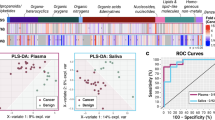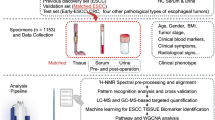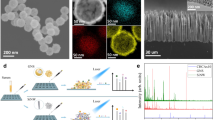Abstract
Background
Nasopharyngeal carcinoma (NPC) is a complex cancer influenced by various factors. This study explores the use of single-cell Raman spectroscopy as a potential diagnostic tool for investigating biomolecular changes associated with NPC carcinogenesis.
Methods
Seven NPC cell lines, one immortalised nasopharyngeal epithelial cell line, six nasopharyngeal mucosa tissues and seven NPC tissue samples were analysed by performing confocal Raman spectroscopic measurements and imaging. The single-cell Raman spectral dataset was used to quantify relevant biomolecules and build machine learning classification models. Metabolomic profiles were investigated using ultra-performance liquid chromatography-tandem mass spectrometer (UPLC-MS/MS).
Results
By generating a metabolic map of seven NPC cell lines, we identified an interplay of altered metabolic processes involving nucleic acids, amino acids, lipids and sugars. The results from spatially resolved Raman maps and UPLC-MS/MS metabolomics were consistent, revealing an increase of unsaturated fatty acids in cancer cells, particularly in highly metastatic 5–8F and poorly differentiated CNE2 cells. The classification model achieved a nearly perfect classification when identifying NPC and non-NPC cells with an ROC-AUC of 0.99 and a value of 0.97 when identifying 13 tissue samples.
Conclusion
This study unveils a complex interplay of metabolic network and highlights the potential roles of unsaturated fatty acids in NPC progression and metastasis. This renders further research to provide deeper insights into NPC pathogenesis, identify new metabolic targets and improve the efficacy of targeted therapies in NPC. Artificial intelligence-aided analysis of single-cell Raman spectra has achieved high accuracies in the classification of both cancer cells and patient tissues, paving the way for a simple, less invasive and accurate diagnostic test.
This is a preview of subscription content, access via your institution
Access options
Subscribe to this journal
Receive 24 print issues and online access
$259.00 per year
only $10.79 per issue
Buy this article
- Purchase on Springer Link
- Instant access to full article PDF
Prices may be subject to local taxes which are calculated during checkout






Similar content being viewed by others
Data availability
Datasets generated and analysed for this study are available from corresponding authors upon request.
References
Chen YP, Chan ATC, Le QT, Blanchard P, Sun Y, Ma J. Nasopharyngeal carcinoma. Lancet. 2019;394:64–80.
Chang ET, Adami HO. The enigmatic epidemiology of nasopharyngeal carcinoma. Cancer Epidemiol Biomark Prev. 2006;15:1765–77.
Chan SH. Aetiology of nasopharyngeal carcinoma. Ann Acad Med Singap. 1990;19:201–7.
Tao Q, Chan ATC. Nasopharyngeal carcinoma: molecular pathogenesis and therapeutic developments. Expert Rev Mol Med. 2007;9:1–24.
E A R ENS, Irekeola AA, Yean Yean C. Diagnostic and prognostic indications of nasopharyngeal carcinoma. Diagnostics. 2020;10:611.
Wang KH, Austin SA, Chen SH, Sonne DC, Gurushanthaiah D. Nasopharyngeal carcinoma diagnostic challenge in a nonendemic setting: our experience with 101 patients. Perm J. 2017;21:16–180.
Dou H, Hu D, Lam C, Liu Y, Wang X, Zhang W. Retrospective analysis of results of treatment for nasopharyngeal carcinoma in Macao. Chin J Cancer Res. 2014;26:148–58.
Dickson RI. Nasopharyngeal carcinoma: an evaluation of 209 patients. Laryngoscope.1981;91:333–54.
Li T, Li F, Guo X, Hong C, Yu X, Wu B, et al. Anti-epstein-barr virus BNLF2b for mass screening for nasopharyngeal cancer. N Engl J Med. 2023;389:808–19.
Yang T, You C, Meng S, Lai Z, Ai W, Zhang J. EBV infection and its regulated metabolic reprogramming in nasopharyngeal tumorigenesis. Front Cell Infect Microbiol. 2022;12:935205.
Janvilisri T. Omics-based identification of biomarkers for nasopharyngeal carcinoma. Dis Markers. 2015;2015:762128.
Huang WE, Griffiths RI, Thompson IP, Bailey MJ, Whiteley AS. Raman microscopic analysis of single microbial cells. Anal Chem. 2004;76:4452–8.
Xu J, Yu T, Zois CE, Cheng JX, Tang Y, Harris AL, et al. Unveiling cancer metabolism through spontaneous and coherent raman spectroscopy and stable isotope probing. Cancers. 2021;13:1718.
Ming LC, Gangodu NR, Loh T, Zheng W, Wang J, Lin K, et al. Real time near-infrared Raman spectroscopy for the diagnosis of nasopharyngeal cancer. Oncotarget.2017;8:49443–50.
Li Y, Su S, Zhang Y, Liu S, Jin H, Zeng Q, et al. Accuracy of Raman spectroscopy in discrimination of nasopharyngeal carcinoma from normal samples: a systematic review and meta-analysis. J Cancer Res Clin Oncol. 2019;145:1811–21.
Saadatpour A, Lai S, Guo G, Yuan GC. Single-cell analysis in cancer genomics. Trends Genet. 2015;31:576–86.
Lee KS, Landry Z, Pereira FC, Wagner M, Berry D, Huang WE, et al. Raman microspectroscopy for microbiology. Nat Rev Methods Prim. 2021;1:80.
Lasch P. Spectral pre-processing for biomedical vibrational spectroscopy and microspectroscopic imaging. Chemom Intell Lab Syst. 2012;117:100–14.
Xu J, Preciado-Llanes L, Aulicino A, Decker CM, Depke M, Gesell Salazar M, et al. Single-cell and time-resolved profiling of intracellular Salmonella metabolism in primary human cells. Anal Chem. 2019;91:7729–37.
Belay B, Esteban-Cruciani N, Walsh CA, Kaskel FJ. The use of levo-carnitine in children with renal disease: a review and a call for future studies. Pediatr Nephrol. 2006;21:308–17.
Rubakhin SS, Romanova EV, Nemes P, Sweedler JV. Profiling metabolites and peptides in single cells. Nat Methods. 2011;8:S20–9.
Huang H, Li S, Tang Q, Zhu G. Metabolic reprogramming and immune evasion in nasopharyngeal carcinoma. Front Immunol. 2021;12. https://www.frontiersin.org/articles/10.3389/fimmu.2021.680955. Accessed 7 Mar 2023.
Sobanski T, Rose M, Suraweera A, O’Byrne K, Richard DJ, Bolderson E. Cell metabolism and DNA repair pathways: implications for cancer therapy. Front Cell Dev Biol [Internet]. 2021;9. Available from: https://www.frontiersin.org/articles/10.3389/fcell.2021.633305. Accessed 6 Mar 2023.
Wanders RJA, Duran M, Loupatty FJ. Enzymology of the branched-chain amino acid oxidation disorders: the valine pathway. J Inherit Metab Dis. 2012;35:5–12.
Fu S, Li Z, Xiao L, Hu W, Zhang L, Xie B, et al. Glutamine synthetase promotes radiation resistance via facilitating nucleotide metabolism and subsequent dna damage repair. Cell Rep. 2019;28:1136–43.e4.
Altman BJ, Stine ZE, Dang CV. From krebs to clinic: glutamine metabolism to cancer therapy. Nat Rev Cancer. 2016;16:619–34.
Qi CL, Huang ML, Zou Y, Yang R, Jiang Y, Sheng JF, et al. The IRF2/CENP-N/AKT signaling axis promotes proliferation, cell cycling and apoptosis resistance in nasopharyngeal carcinoma cells by increasing aerobic glycolysis. J Exp Clin Cancer Res. 2021;40:390.
Zhao W, Xiang Y, Zhang Z, Liu X, Jiang M, Jiang B, et al. Pharmacological inhibition of GSK3 promotes TNFα-induced GM-CSF via up-regulation of ERK signaling in nasopharyngeal carcinoma (NPC). Int Immunopharmacol. 2020;83:106447.
Koundouros N, Poulogiannis G. Reprogramming of fatty acid metabolism in cancer. Br J Cancer. 2020;122:4–22.
Fang Z, Huang H, Wang L, Lin Z. Identification of the alpha linolenic acid metabolism-related signature associated with prognosis and the immune microenvironment in nasopharyngeal carcinoma. Front Endocrinol. 2022;13:968984.
Luo SD, Tsai HT, Chiu TJ, Li SH, Hsu YL, Su LJ, et al. Leptin silencing attenuates lipid accumulation through sterol regulatory element-binding protein 1 inhibition in nasopharyngeal carcinoma. Int J Mol Sci. 2022;23:5700.
Röhrig F, Schulze A. The multifaceted roles of fatty acid synthesis in cancer. Nat Rev Cancer. 2016;16:732–49.
Peck B, Schug ZT, Zhang Q, Dankworth B, Jones DT, Smethurst E, et al. Inhibition of fatty acid desaturation is detrimental to cancer cell survival in metabolically compromised environments. Cancer Metab. 2016;4:6.
Hess D, Chisholm JW, Igal RA. Inhibition of StearoylCoA desaturase activity blocks cell cycle progression and induces programmed cell death in lung cancer cells. PLOS One. 2010;5:e11394.
Zhang P, He Q, Wang Y, Zhou G, Chen Y, Tang L, et al. Protein C receptor maintains cancer stem cell properties via activating lipid synthesis in nasopharyngeal carcinoma. Signal Transduct Target Ther. 2022;7:1–11.
Góral J, Zichy V. Fourier transform Raman studies of materials and compounds of biological importance. Spectrochim Acta Part A Mol Spectrosc. 1990;46:253–75.
Wiercigroch E, Szafraniec E, Czamara K, Pacia MZ, Majzner K, Kochan K, et al. Raman and infrared spectroscopy of carbohydrates: a review. Spectrochim Acta Part A Mol Biomol Spectrosc. 2017;185:317–35.
Chan JW, Taylor DS, Zwerdling T, Lane SM, Ihara K, Huser T. Micro-Raman spectroscopy detects individual neoplastic and normal hematopoietic cells. Biophys J. 2006;90:648–56.
Pezzotti G. Raman spectroscopy in cell biology and microbiology. J Raman Spectrosc. 2021;52:2348–443.
Zhu G, Zhu X, Fan Q, Wan X. Raman spectra of amino acids and their aqueous solutions. Spectrochim Acta Part A Mol Biomol Spectrosc. 2011;78:1187–95.
Ruiz‐Chica AJ, Medina MA, Sánchez‐Jiménez F, Ramírez FJ. Characterization by Raman spectroscopy of conformational changes on guanine–cytosine and adenine–thymine oligonucleotides induced by aminooxy analogues of spermidine. J Raman Spectrosc. 2004;35:93–100.
Czamara K, Majzner K, Pacia MZ, Kochan K, Kaczor A, Baranska M. Raman spectroscopy of lipids: a review. J Raman Spectrosc. 2015;46:4–20.
Stone N, Stavroulaki P, Kendall C, Birchall M, Barr H. Raman spectroscopy for early detection of laryngeal malignancy: preliminary results. Laryngoscope. 2000;110:1756–63.
Movasaghi Z, Rehman S, Rehman DIU. Raman spectroscopy of biological tissues. Appl Spectrosc Rev. 2007;42:493–541.
Stone N, Kendall C, Shepherd N, Crow P, Barr H. Near-infrared Raman spectroscopy for the classification of epithelial pre-cancers and cancers. J Raman Spectrosc. 2002;33:564–73.
Rygula A, Majzner K, Marzec KM, Kaczor A, Pilarczyk M, Baranska M. Raman spectroscopy of proteins: a review. J Raman Spectrosc. 2013;44:1061–76.
Acknowledgements
We thank Professor Musheng Zeng from Sun Yat-Sen University Cancer Center for providing cell lines used in this study.
Funding
This study was supported by the National Natural Science Foundation of China (Grant No. 81772921). A grant from the Science and Technology Planning Project of Shenzhen City of China (JCYJ20230807142806014, JCYJ20190812171816857, JCYJ20180306172209668, JCYJ20190812171215641). Sanming Project of Medicine in Shenzhen (No. SZSM201601062). Shenzhen Key Medical Discipline (No. SZXK054). WEH thanks National Key R&D Program of China (2022YFC2403300) and Suzhou Institute of Biomedical Engineering and Technology, Chinese Academy of Sciences for financial support.
Author information
Authors and Affiliations
Contributions
Dan Xiong and Dayang Chen, established and supervised the study. Xiaowen Dou, Xiaojuan Gao and Xiuming Zhang designed analysis framework. Dan Xiong and Wei E. Huang designed Raman experiments. Wei Wu and Xiang Ji performed the experiments. Jiabao Xu performed data analysis and visualisation. Dan Xiong, Dayang Chen, Jiabao Xu and Wei E. Huang interpreted the data. Jiabao Xu wrote the original manuscript. Dan Xiong, Wei E. Huang made manuscript revisions. All authors reviewed the results and approved the final version of the manuscript.
Corresponding authors
Ethics declarations
Competing interests
The authors declare no competing interests.
Ethics approval and consent to participate
Written informed consent was obtained from the patients included in this study, and approvals from the First Affiliated Hospital of Sun Yat-sen University hospital were obtained to use the clinical samples (No. 2020-483).
Additional information
Publisher’s note Springer Nature remains neutral with regard to jurisdictional claims in published maps and institutional affiliations.
Supplementary information
Rights and permissions
Springer Nature or its licensor (e.g. a society or other partner) holds exclusive rights to this article under a publishing agreement with the author(s) or other rightsholder(s); author self-archiving of the accepted manuscript version of this article is solely governed by the terms of such publishing agreement and applicable law.
About this article
Cite this article
Xu, J., Chen, D., Wu, W. et al. A metabolic map and artificial intelligence-aided identification of nasopharyngeal carcinoma via a single-cell Raman platform. Br J Cancer (2024). https://doi.org/10.1038/s41416-024-02637-3
Received:
Revised:
Accepted:
Published:
DOI: https://doi.org/10.1038/s41416-024-02637-3



